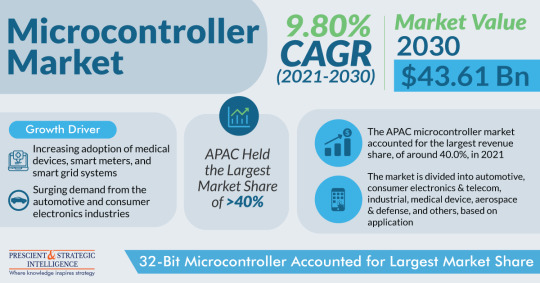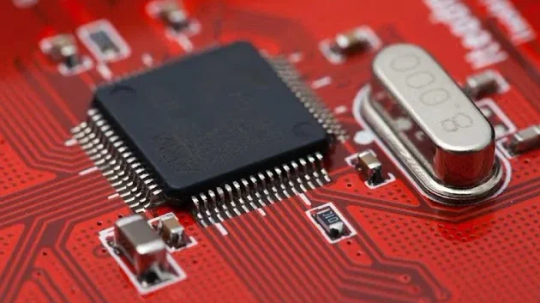#Microcontroller Market Size
Explore tagged Tumblr posts
Text
Microcontroller Market To Reach a Value of About $44 Billion by 2030
The size of the microcontroller market was about $19 billion in 2021, and will reach about $44 billion by 2030, at a growth rate of 10% in the future. The growth industry can be attributed to the increasing demand for microcontrollers in the automotive sectors, the increasing acceptance of medical and healthcare devices, and the increasing use of IoT devices.

32-bit microcontrollers had over 40% share in the past, and will grow at a rate of over 10% in the years to come. This growth has a lot to do with the increasing use of 32-bit microcontrollers in the automotive industry and the decrease in prices of microcontrollers. Further, strict regulations of the government and quality standards for emissions will boost the acceptance of these microcontrollers globally.
16-bit microcontrollers followed the 32-bit ones. This is because of the surging demand from the automotive sector for manufacturing EV modules accompanied by the incessant decrease in the selling prices. This microcontroller can manage data with 16 bits, letting it to accomplish a larger data volume and computations together. It also needs less power and functions at a quicker than an 8-bit microcontroller.
Consumer electronics & telecom sector is an industrial dominator, with over 40% share in the past, and will grow at a considerable rate in the near future. This has a lot to do with the rising acceptance of consumer electronics like TVs, cameras, computers, and smartphones, accompanied by the decline in sizes of electronic devices.
APAC was the dominator of the microcontroller marketin the recent past. This is credited to the fast growth in the sales of automobiles and the increasing requirement for sophisticated consumer electronics. Furthermore, the explosion of start-ups in India and China, which offering essential microcontroller solutions, accompanied by advanced supplementary products and services, like entertainment and GPS navigation systems, is responsible for the regional industrial growth.
North America followed the APAC in terms of revenue sharing in the past, because of the existence of a large number of consumers demanding consumer gadgets and the increasing requirement for medical devices, smart wearables, sensors, and other IoT-enabled products in Canada and the U.S., which boosts the need for microcontrollers.
The medical devices sector will see an increase in the requirement for microcontrollers, because of the high requirement for accurateness in medical processes, increased research and development funding for the expansion of innovative medical apparatus, and support of the government for medical automation.
Also, the increasing elderly population and increasing number of people having chronic diseases like diabetes and high BP, accompanied by mounting covid infection, are some factors increasing the demand for electronic medical devices globally, which will help the industry to grow at a rapid pace.
The increasing use of medical devices and smart meters, and growing requirement of microcontrollers from consumer electronics and automotive industries are pushing the global demand for microcontrollers.
Source: P&S Intelligence
#Microcontroller Market Share#Microcontroller Market Size#Microcontroller Market Growth#Microcontroller Market Applications#Microcontroller Market Trends
1 note
·
View note
Text
Automotive Semiconductor Market Size, Trends, Opportunities, and Growth Forecast 2025-2032

The automotive semiconductor market is rapidly evolving, driven by the increasing integration of advanced electronics and smart technology in vehicles. With innovations in ADAS, electric vehicles, and connected cars, the industry is poised for substantial transformation and growth. Market dynamics, including regulatory mandates on safety and emissions, are pushing semiconductor adoption, shaping business growth and competitive strategies. Market Size and Overview Global Automotive Semiconductor Market is estimated to be valued at USD 77.27 billion in 2025 and is expected to reach USD 135.02 billion by 2032, exhibiting a compound annual growth rate (CAGR) of 8.3% from 2025 to 2032.
This Automotive Semiconductor Market Growth is fueled by rising demand for electric vehicles, enhanced vehicle connectivity, and growing adoption of autonomous driving features. Market trends show notable shifts toward higher computing power in vehicles, influencing market revenue and industry share. The market scope increasingly covers microcontrollers, sensors, power semiconductors, and other components critical for next-generation automotive applications.
Get More Insights On- Automotive Semiconductor Market
#Automotive Microcontrollers#Connected Car Semiconductors#Automotive Semiconductor#Automotive Semiconductor Market#Automotive Semiconductor Market Insights#Automotive Semiconductor Market Size#Coherent Market Insights
0 notes
Text
Global Microcontroller Market: Emerging Technologies and Competitive Landscape
The Global Microcontroller Market is expected to reach USD 52 Billion by 2030, at a CAGR of 8% during the forecast period 2022 to 2030.

Microcontrollers: The Compact Controllers Powering Embedded Systems
A microcontroller is a small integrated circuit combining a processor, memory, and programmable input/output on one chip to manage specific tasks in embedded systems. They are widely used in devices like automotive engine controls, medical implants, remote controls, appliances, and power tools. In 2005, 8-bit microcontrollers made up about 45% of global CPU sales. Today, microcontrollers play a crucial role across industries including automotive, consumer electronics, industrial, healthcare, and aerospace & defense.
This study gives a detailed analysis of drivers, restrains, opportunities and challenges limiting the market expansion of Microcontroller market. The survey included a diverse set of players, including a balance of leading and growing manufacturers for business profiling, such as;
Analog Devices Inc., Intel Corporation, Yamaichi Electronics Co., Ltd., ON Semiconductor, Panasonic Corporation, QuickLogic, STMicroelectronics N.V., Ambiq Micro, Inc., Fujitsu Semiconductor Limited, Zilog, Inc., Diedevices, ELAN Electrronics, Gigadevice, TE Connectivity Ltd., Samsung Semiconductors, Microchip Technology Inc., Seiko Epson Corporation, Texas Instruments Incorporated, Renesas Electronics Corporation,Toshiba Electronic Devices & Storage Corporation, ROHM Co., Ltd., Infineon Technologies AG, Nuvoton Technology Corporation, NXP Semiconductor
Our expert team is consistently working on updated data and information on the key player's related business processes that value the market for future strategies and predictions
Get Access to a Free Copy of Our Latest Sample Report - https://www.sphericalinsights.com/request-sample/1564
Market Segmentation:
By Product Type
8-Bit
16-Bit
32-Bit
By Application Type
Automotive
Consumer Electronics
Industrial
Telecom
Healthcare
Aerospace & Defense
Others
Covered in this Report:
1. Go-to-market Strategy. 2. Neutral perspective on the market performance. 3. Development trends, competitive landscape analysis, supply side analysis, demand side analysis, year-on-year growth, competitive benchmarking, vendor identification, QMI quadrant, and other significant analysis, as well as development status. 4. Customized regional/country reports as per request and country level analysis. 5. Potential & niche segments and regions exhibiting promising growth covered. 6.Analysis of Market Size (historical and forecast), Total Addressable Market (TAM), Serviceable Available Market (SAM), Serviceable Obtainable Market (SOM), Market Growth, Technological Trends, Market Share, Market Dynamics, Competitive Landscape and Major Players (Innovators, Start-ups, Laggard, and Pioneer).
Buy this report now:- https://www.sphericalinsights.com/checkout/1564
Industry Developments:
In April 2020, Infineon Technologies launched the TraveoTM II Body microcontroller family for next-generation vehicle electronic systems. The device line is designed to address a wide range of automotive applications, such as body control modules, door, window, sunroof, and seat control units.
Regional Analysis for Microcontroller Market:
✫ North America: (U.S., Canada, Mexico) ✫ Europe: (U.K., Italy, Germany, Russia, France, Spain, The Netherlands and Rest of Europe) ✫ Asia-Pacific: (India, Japan, China, South Korea, Australia, Indonesia Rest of Asia Pacific) ✫ South America: (Colombia, Brazil, Argentina, Rest of South America) ✫ Middle East & Africa: (Saudi Arabia, U.A.E., South Africa, Rest of Middle East & Africa)
Benefits of the Report:
⏩ A descriptive analysis of demand-supply gap, market size estimation, SWOT analysis, PESTEL Analysis and forecast in the global market. ⏩ Top-down and bottom-up approach for regional analysis ⏩ Porter’s five forces model gives an in-depth analysis of buyers and suppliers, threats of new entrants & substitutes and competition amongst the key market players. ⏩ By understanding the value chain analysis, the stakeholders can get a clear and detailed picture of this Market
Insightful inquiry before buying:- https://www.sphericalinsights.com/inquiry-before-buying/1564
Frequently asked questions:
➥ What is the market size of the Microcontroller market? ➥ What is the market growth rate of the Microcontroller market? ➥ What are the Microcontroller market opportunities and threats faced by the vendors in the global Microcontroller Industry? ➥ Which application/end-user or product type may seek incremental growth prospects? What is the market share of each type and application? ➥ What focused approach and constraints are holding the Microcontroller market? ➥ What are the different sales, marketing, and distribution channels in the global industry?
Unlock the full report now! @ https://www.sphericalinsights.com/reports/microcontroller-market
Related Reports:
https://www.sphericalinsights.com/jp/reports/japan-printer-ink-cartridge-market
https://www.sphericalinsights.com/jp/reports/united-kingdom-cattle-feed-market
https://www.sphericalinsights.com/jp/reports/sustainable-phosphorus-market
https://www.sphericalinsights.com/jp/reports/japan-travel-accessories-market
https://www.sphericalinsights.com/jp/reports/container-flexitank-market
https://www.sphericalinsights.kr/reports/chromium-phosphate-market
https://www.sphericalinsights.kr/reports/extreme-lateral-interbody-fusion-surgery-market
https://www.sphericalinsights.kr/reports/extreme-lateral-interbody-fusion-surgery-market
https://www.sphericalinsights.kr/reports/trekking-poles-market
https://www.sphericalinsights.kr/reports/pet-insurance-market
https://www.sphericalinsights.com/ko/reports/spain-oleochemicals-market
https://www.sphericalinsights.com/ko/reports/spain-biogas-market
https://www.sphericalinsights.com/ko/reports/south-korea-battery-energy-storage-market
https://www.sphericalinsights.com/ko/reports/united-states-data-driven-healthcare-market
https://www.sphericalinsights.com/ko/reports/united-states-bpo-business-analytics-market
https://www.sphericalinsights.com/reports/visible-light-range-scientific-camera-market
https://www.sphericalinsights.com/reports/electronic-shelf-labels-market
https://www.sphericalinsights.com/reports/japan-electric-bikes-e-bikes-market
https://www.sphericalinsights.com/reports/japan-instant-coffee-market
https://www.sphericalinsights.com/reports/low-temperature-powder-coatings-market
About the Spherical Insights
Spherical Insights is a market research and consulting firm which provides actionable market research study, quantitative forecasting and trends analysis provides forward-looking insight especially designed for decision makers and aids ROI.
which is catering to different industry such as financial sectors, industrial sectors, government organizations, universities, non-profits and corporations. The company's mission is to work with businesses to achieve business objectives and maintain strategic improvements.
Contact Us:
Company Name: Spherical Insights
Email: [email protected]
Phone: +1 303 800 4326 (US)
Follow Us: LinkedIn | Facebook | Twitter
#Microcontroller Market#Global Microcontroller Market#Microcontroller Market Size#Microcontroller Market Share#Microcontroller Market Analysis#Microcontroller Market Growth
0 notes
Text

#IoT Microcontroller (MCU) Market#IoT Microcontroller (MCU) Market Share#IoT Microcontroller (MCU) Market Size#IoT Microcontroller (MCU) Market Research#IoT Microcontroller (MCU) Industry#What is IoT Microcontroller (MCU)?
0 notes
Text
Microcontroller Unit Market is expected to register a CAGR of 9.7% By 2029

Global Microcontroller Unit Market is rising due to increasing demand for smart devices, IoT applications, and automation across various industries in the forecast period 2025-2029.
According to TechSci Research report, “Microcontroller Unit Market - Industry Size, Share, Trends, Competition Forecast & Opportunities, 2029”, The Global Microcontroller Unit (MCU) Market is experiencing significant growth driven by the escalating demand for smart devices, Internet of Things (IoT) applications, and automation in diverse industries. MCUs, which are compact integrated circuits comprising a processor core, memory, and programmable input/output peripherals, play a crucial role in controlling various electronic devices. The proliferation of smart appliances, wearable gadgets, automotive advancements, and industrial automation has propelled the market's expansion.
Additionally, the increasing adoption of MCUs in sectors such as healthcare, consumer electronics, and telecommunications is fueling market growth. Furthermore, technological advancements, such as the development of energy-efficient and high-performance MCUs, are enhancing their applicability in complex systems. Moreover, the rise of edge computing, where data is processed closer to the data source, is driving the demand for MCUs in edge devices, augmenting their market reach.
As businesses continue to invest in digital transformation and IoT solutions, the Global MCU Market is anticipated to flourish, presenting lucrative opportunities for manufacturers and stakeholders. However, the market also faces challenges related to intense competition and evolving technological standards, necessitating constant innovation and strategic partnerships for sustained growth.
Browse over XX market data Figures spread through XX Pages and an in-depth TOC on "Global Microcontroller Unit Market”. https://www.techsciresearch.com/report/microcontroller-unit-market/20928.html
The Global Microcontroller Unit (MCU) Market, a pivotal sector within the semiconductor industry, has undergone remarkable evolution in recent years, shaping the foundation of modern technological advancements. MCUs, compact integrated circuits comprising a processor core, memory, and programmable input/output peripherals, serve as the brains behind an extensive array of electronic devices, ranging from everyday consumer gadgets to intricate industrial automation systems. One of the key driving forces behind the market's growth is the escalating demand for smart devices and the Internet of Things (IoT) applications.
The surge in IoT technology has led to an unprecedented proliferation of interconnected devices, each powered by MCUs, facilitating seamless communication, data processing, and automation. From smart home appliances and wearable devices to industrial sensors and healthcare equipment, MCUs have become the backbone of the interconnected world, enabling unprecedented levels of efficiency, convenience, and innovation.
Furthermore, the automotive industry has emerged as a significant driver, propelling the demand for advanced MCUs. Modern vehicles are equipped with a plethora of electronic systems, such as engine control units, infotainment systems, and advanced driver-assistance systems (ADAS), each relying on MCUs for optimal performance. The evolution towards electric vehicles (EVs) and autonomous driving technologies has further bolstered the need for high-performance MCUs capable of handling complex computations and ensuring real-time responsiveness. This trend underscores the critical role MCUs play in reshaping the automotive landscape, enhancing safety, efficiency, and driving experiences.
Another compelling factor fueling the MCU market is the relentless march of automation across various industries. Manufacturing plants, logistics centers, and even offices are increasingly relying on MCUs to automate processes, optimize operations, and reduce human intervention. MCUs enable seamless integration of sensors, robotics, and control systems, transforming traditional industries into smart, interconnected ecosystems. This trend not only improves productivity but also drives the demand for specialized MCUs tailored to industrial automation requirements, contributing significantly to market growth.
Moreover, the healthcare sector has embraced MCUs, incorporating them into an array of medical devices and diagnostic equipment. From wearable health trackers and smart prosthetics to high-tech imaging devices, MCUs enable precise control, data processing, and real-time monitoring, enhancing patient care and medical outcomes. The integration of MCUs into healthcare applications exemplifies the market's adaptability and its ability to address diverse industry needs.
Additionally, MCUs continue to find extensive applications in aerospace and defense, where reliability, performance, and ruggedness are paramount. These applications, often involving extreme conditions and critical missions, rely on MCUs to deliver optimal performance and ensure the functionality of sophisticated avionics systems, navigation equipment, and military hardware.
In conclusion, the Global Microcontroller Unit Market stands at the forefront of technological innovation, enabling the seamless integration of smart devices, automation, and connectivity across diverse industries. With the relentless pursuit of efficiency, connectivity, and intelligence characterizing the modern era, the MCU market is poised for continuous growth, shaping the future of industries and transforming the way people live, work, and interact with the world around them.
The Global Microcontroller Unit Market is segmented into Product, Application, regional distribution, and company. Based on Product, the 32-bit microcontroller unit (MCU) segment emerged as the dominant force in the Global Microcontroller Unit Market and is anticipated to maintain its supremacy throughout the forecast period. The 32-bit MCUs gained prominence due to their superior processing power, extensive memory capacity, and versatility in handling complex applications across various sectors.
Industries such as automotive, industrial automation, and consumer electronics increasingly rely on 32-bit MCUs to support advanced features like high-resolution displays, intricate algorithms, and multitasking capabilities. These microcontrollers offer a perfect balance between performance and energy efficiency, making them ideal for applications demanding substantial computational capabilities while ensuring optimal power consumption.
Additionally, the 32-bit MCUs have witnessed rapid advancements in terms of integration of features such as wireless connectivity and enhanced security protocols, aligning them with the evolving requirements of modern IoT applications. Their ability to handle sophisticated tasks and accommodate future technological developments positions them as the preferred choice for manufacturers and developers. As industries continue to demand more sophisticated, feature-rich, and power-efficient solutions, the 32-bit MCU segment is expected to maintain its dominance, driving innovation and shaping the landscape of the Global Microcontroller Unit Market in the foreseeable future.
Based on region, Asia-Pacific stood out as the dominating region in the Global Microcontroller Unit (MCU) Market, and it is anticipated to maintain its dominance during the forecast period. Several factors contribute to Asia-Pacific's market leadership, including the presence of key MCU manufacturing hubs in countries like China, Japan, South Korea, and Taiwan. These countries have established themselves as major players in the global semiconductor industry, producing a substantial portion of the world's MCUs.
Additionally, the region's robust electronics manufacturing ecosystem, technological expertise, and the continuous demand for consumer electronics, automotive components, and industrial automation solutions have fueled the growth of the MCU market. Rising investments in research and development, coupled with favorable government policies supporting the semiconductor sector, further contribute to the region's dominance.
Moreover, the proliferation of IoT applications, smart devices, and digitalization efforts across various industries in Asia-Pacific continues to drive the demand for advanced MCUs. With a strong manufacturing base, technological innovation, and a growing market for electronic products, Asia-Pacific is well-positioned to maintain its leadership in the Global Microcontroller Unit Market in the foreseeable future.
Major companies operating in Global Microcontroller Unit Market are:
Renesas Electronics Corporation
NXP Semiconductors N.V.
Texas Instruments Incorporated
STMicroelectronics N.V.
Infineon Technologies AG
Microchip Technology Inc.
Cypress Semiconductor Corporation
Analog Devices, Inc.
Silicon Laboratories Inc.
Maxim Integrated Products, Inc.
Download Free Sample Report https://www.techsciresearch.com/sample-report.aspx?cid=20928
Customers can also request for 10% free customization on this report.
“The Global Microcontroller Unit (MCU) Market, a vital segment within the semiconductor industry, has evolved significantly, shaping modern technological advancements. MCUs, compact integrated circuits comprising a processor core, memory, and programmable input/output peripherals, serve as the brains behind a wide array of electronic devices, from consumer gadgets to complex industrial automation systems. The market's growth is propelled by the surging demand for smart devices and Internet of Things (IoT) applications. MCUs power interconnected devices, facilitating seamless communication and automation, from smart home appliances to healthcare equipment.
The automotive industry is a major driver, demanding advanced MCUs for electronic systems in vehicles, enhancing safety and efficiency. Automation across industries further fuels the market, with MCUs integrating sensors and robotics, optimizing operations. Additionally, MCUs play a vital role in healthcare devices, improving patient care, and find applications in aerospace and defense for their reliability. As industries prioritize efficiency and connectivity, the MCU market continues to innovate, shaping the future of diverse sectors,” said Mr. Karan Chechi, Research Director with TechSci Research, a research-based management consulting firm.
“Microcontroller Unit Market – Global Industry Size, Share, Trends, Opportunity, and Forecast, Segmented By Product (8-bit, 16-bit, 32-bit), By Application (Consumer Electronics & Telecom, Automotive, Industrial, Medical Devices, Aerospace & Defense, Others), By Region, By Competition, 2019-2029”, has evaluated the future growth potential of Global Microcontroller Unit Market and provides statistics & information on market size, structure and future market growth. The report intends to provide cutting-edge market intelligence and help decision makers take sound investment decisions. Besides, the report also identifies and analyzes the emerging trends along with essential drivers, challenges, and opportunities in Global Microcontroller Unit Market.
Contact
TechSci Research LLC
420 Lexington Avenue, Suite 300,
New York, United States- 10170
Tel: +1-332-258-6602
Email: [email protected]
Website: www.techsciresearch.com
#Microcontroller Unit Market#Microcontroller Unit Market Size#Microcontroller Unit Market Share#Microcontroller Unit Market Trends#Microcontroller Unit Market Growth#Microcontroller Unit Market Forecast
0 notes
Text
#Global Low-Power Microcontroller Unit Market Size#Share#Trends#Growth#Industry Analysis#Key Players#Revenue#Future Development & Forecast
0 notes
Text
#8 - bit Microcontroller Market#8 - bit Microcontroller Market size#8 - bit Microcontroller Market share#8 - bit Microcontroller Market trends#8 - bit Microcontroller Market analysis#8 - bit Microcontroller Market forecast
0 notes
Text

Newxie brings the joy of nixies without the 170V power supply 💡🕰️✨
If there's one thing that melts our hearts, it's a nixie clock - we built one 20 years ago!
but nixies are hard to find now that we don't hit up the MIT swapfest at 7am anymore
well we saw this funky faux nixie clock
http://www.unitedcreation.co/marvel-tubes/
and realized they're just using the same 1.14" TFTs we stock already
so why not re-spin the breakout into a skinny right-angle-mount version? Instead of card edge, we have 2x7 right angle headers - both rows are the same contact, but this way, we get more mechanical stability. We kept the level shifting to work with 3.3V or 5V microcontrollers but dropped the micro SD card. You could stack these side by side on a breadboard with as little as 0.7" pitch!
#nixieclock#electronics#makercommunity#arduino#tftdisplay#creativeprojects#vintagestyle#retrodesign#diyelectronics#makersgonnamake#openhardware#engineeringfun#microcontrollers#electronicsprojects#techhacks#techinnovation#mitcommunity#geeklife#retroaesthetic#buildcoolstuff
39 notes
·
View notes
Text
Automotive Power Electronics Market Growing Business Factors, Industry Trends, Share, Size, Growth, Opportunity And Forecast 2033
According to a new industry report by Fact.MR, a market research and competitive intelligence provider, the global automotive power electronics market is projected to reach $6 billion by 2033, growing at a CAGR of 4.1% from 2023 to 2033.
Power electronics encompass a wide range of solid-state devices used for power regulation and conversion, including silicon-controlled rectifiers (SCRs), diodes, thyristors, power MOSFETs, gate turn-off thyristors, and more. These devices are crucial in controlling vehicle electronics. The term "automotive electronics" covers the application of power electronic devices in modern systems such as electric power steering, seat control, braking systems, central body management, and HEV main inverters.
Download Free Sample Copy of This Report: https://www.factmr.com/connectus/sample?flag=S&rep_id=8423
The rising popularity of electric vehicles (EVs) is the primary driver of the global automotive power electronics market. EVs are seen as a crucial step toward modern mobility solutions, offering cleaner and more efficient transportation compared to traditional automobiles. The depletion of fuel resources and public concern over increasing pollution levels have fueled global demand for electric vehicles.
Compliance with safety and vehicle emission standards, along with the growing demand for vehicle connectivity, infotainment, and powertrain electrification, is expected to propel the global automotive power electronics market during the forecast period. The use of electronics in powertrain systems is projected to increase at a faster rate due to intensified efforts by regional governments and environmental agencies to reduce emissions by promoting environmentally friendly vehicles, such as hybrids and EVs.
Key Takeaways from Market Study
In 2023, the global automotive power electronics market was valued at $4 billion.
The market is projected to grow at a CAGR of 4.1% from 2023 to 2033, reaching $6 billion by 2033.
In 2022, the Asia Pacific region held 38.7% of the global market share.
The passenger car segment is anticipated to grow at a CAGR of 3.7% during the forecast period.
“Global automotive power electronics market projected to witness considerable growth due to increasing modernization of vehicles, expanding demand for vehicle electrification, and rising need for connected car devices,” says a Fact.MR analyst.
Key Companies Profiled in Automotive Power Electronics Market Report
Infineon Technologies AG
Texas Instruments, Inc
Mitsubishi Electric Corporation
NXP Semiconductors NV
Toshiba Corporation
Robert Bosch GmbH
Get Customization on this Report for Specific Research Solutions: https://www.factmr.com/connectus/sample?flag=RC&rep_id=8423
Competitive Landscape
Big manufacturers control the market, which is only moderately concentrated. The leading companies in the automotive power electronics sector are focusing on broadening their product lines and investing in research and development to generate high-end products. In addition, several entrepreneurs are focused on new technologies to boost their market share.
In September 2021, Panasonic Corporation and Infineon Technologies AG signed a collaboration agreement to research and manufacture the second generation (Gen2) of their renowned gallium nitride (GaN) technology. This will enhance efficiency and power density levels.
In June 2021, STMicroelectronics announced STi2GaN solutions for automotive applications. The STi2GaN series includes GaN-based drivers and safeguards, a monolithic power stage, and System-in-Package (SiP) solutions for application-specific integrated circuits with additional processing and control circuitry.
Infineon Technologies AG purchased Cypress Semiconductor Company in April 2020. Cypress provides a diverse set of software ecosystems, microcontrollers, connection components, and high-performance storage.
Infineon Technologies launched the CoolMOS CFD7A family in April 2020. These high-performance silicon-based components can be used in both the PFC and DC-DC stages of onboard charger systems, as well as HV-LV DC-DC converters designed specifically for EV use.
Key Segments of Automotive Power Electronics Industry Research
By Device Type :
Power ICs
Power Modules/Discretes
By Drive Type :
IC Engine Vehicles
Electric Vehicles
By Vehicle Type :
Passenger Cars
Commercial Vehicles
By Electric Vehicle Type :
Battery Electric Vehicles
Hybrid Electric Vehicles
Plug-in Hybrid Electric Vehicles
By Application :
Body Electronics
Chassis & Powertrain
Infotainment & Telematics
Safety & Security Systems
𝐑𝐞𝐚𝐝 𝐌𝐨𝐫𝐞: https://www.factmr.com/report/automotive-power-electronics-market
Regional Analysis
Asia Pacific dominates the worldwide automobile power electronics industry. Japan and South Korea are helping to drive market development in Asia Pacific as automotive production increases.
The North American market is increasing rapidly. The United States dominates the North American market thanks to the existence of major electric vehicle manufacturers such as Tesla. Furthermore, Germany is making a significant contribution to European market growth as electric vehicle usage increases.
𝐂𝐨𝐧𝐭𝐚𝐜𝐭:
US Sales Office 11140 Rockville Pike Suite 400 Rockville, MD 20852 United States Tel: +1 (628) 251-1583, +353-1-4434-232 Email: [email protected]
1 note
·
View note
Text
How Does Rapid Smart Meter Installation Fuel IoT Microcontroller Industry Growth?
The IoT microcontroller industry has generated $4,836.9 million revenue in 2021, and it is projected to rise at a rate of 12.4% from 2021 to 2030. The rising application of IoT across various sectors is projected to fuel the industry in the coming years.

In addition, the demand for connected products, including household appliances, televisions, tablets, security systems, smartphones, and gaming consoles is projected to rise in the coming years, and fuel the industry growth.
The rising focus on the adoption of automation in numerous sectors is projected to fuel industry growth in the coming years. The technological advancements in IoT applications will provide better and more advanced smart products to customers, and it is likely to propel the demand for microcontrollers in the coming years.
Moreover, the quick installation of smart meters across various residential and commercial spaces is projected to fuel the microcontrollers' demand to monitor the total consumption of electrical energy and provide the information to utilities for automated billing.
The transformation in the healthcare industry over the years, led by the adoption of advanced wireless devices, data analytics techniques, and computer-embedded technology propels the IoT microcontroller industry.
Furthermore, IoT technologies transform clinical research by facilitating a massive amount of complex medical information analysis, including bioinformatics, metagenomics, and genomic data. The surging investments in healthcare devices, with the adoption of IoT and Wi-Fi, are expected to expand the industry, and thus boost the advancements in the IoT microcontroller industry in the coming years.
For example, the worldwide population of people aged 60 and more will rise by 16% in 2030, and by 22 % in 2050. It results in a growing burden of chronic diseases, that affects 6 out of 10 citizens every year and hence propels the patient monitoring devices demand in the U.S.
Under the product segment, the 32-bit microcontroller category is projected to lead the industry, with the highest growth of 12.5%, in the near future. It is ascribed to better functional capabilities of these variants, that support advanced IoT applications, small implanted medical devices, and Industrial 4.0 processes.
Such components provide superior efficiency, better performance, and higher processing power compare to other microcontrollers and offer ease of use.
In addition, the 32-bit microcontrollers allow the transfer of real-time sensor information on the IP network. They are considered important due to the rising remote work culture, that requires distributed teams’ management.
Under the application segment, the smart home category propels the industry, and it is projected to experience the fastest growth in the coming years, of over 12.5%. The advancement in app-controlled smart devices has resulted in high demand for secure, safe, and energy-efficient processes, such as lighting, HVAC, and energy management, and it is projected to boost the smart home industry in the coming years.
Moreover, APAC is projected to experience a growth at the rate of 12.5% in the coming years. It is ascribed to advancements in the automobile industry, more specifically, interactive vehicle safety systems, which are expected to fuel the demand for IoT microcontrollers in the coming years.
Therefore, the rising installation of smart meters boost the IoT microcontroller industry growth.
Source: P&S Intelligence
#IoT microcontroller market Share#IoT microcontroller market Size#IoT microcontroller market Growth#IoT microcontroller market Applications#IoT microcontroller market Trends
1 note
·
View note
Text
This is an insane design, who would make a system like this for a CAR, am I misunderstanding what this is saying? I find it hard to believe that a company like Tesla is actually going to design something like this that functions as intended, imagine trying to modify a harness like this by installing something simple like heated seats and the entire fucking truck breaks, I don't give a shit about functionality when the entire vehicle is designed to fail after doing something like a car wash! What about in the case of a crash? You're talking about sending possibly up to 92 volts through these systems in a collision, that'll get those computers, microcontrollers and switches real nice and toasty, I can easily believe that these things are going to be gigantic liability risk billboards in even the tiniest of collisions, oh hooray a car that insurance won't cover when it's involved in any collision regardless of the size. I can't wait for the shit storms of trashed cyber trucks sitting in dealer lots, eventually they won't be able to get the new ones off the lots and they'll have to release a "new and improved version" every few years, ah capitalism the literal definition of "turn a product into a lifestyle, and then watch the money start-a flowing". I love the modern age, its almost like all those sci-fi movies and shows from the 70's somehow predicted these things would happen, oh wait they were judging the current events of their time and predicting how the future would look, and let me tell you, this shit is getting too fucking real for me. Sure the car only lasts two years "but it can dance" its literally the Apple company sickness seeping into other markets, it is truly terrifying to watch several billionaires take over vast coverages of markets so quickly, steamrolling the smaller businesses in the process all the while self-employment is all but wiped out and all the sub-billionare companies are taken over and everything becomes a corporate controlled corrupt government puppet state where free will is annihilated in favor "of maximizing profits" . This is what the world is turning into, and I'm in the generation that is going to have to live through it, I hate baby boomers









#cybertruck#automotive#this is insane#design#capitalist hell#capitalism#fuck capitalism#i hate corporations#repent for your sins against the corporate gods!#death trap#i need antidepressants now
42K notes
·
View notes
Text
3D Snapshot Sensor Market Size Capturing the Future of Real-Time Depth Sensing
In a world driven by smart devices, immersive experiences, and autonomous technologies, 3D snapshot sensors are redefining how machines perceive the world. The 3D Snapshot Sensor Market is experiencing rapid growth as industries embrace real-time depth sensing for precision, safety, and automation. These sensors are at the heart of innovations in AR/VR, robotics, security, and automotive sectors.
According to recent industry analysis, this market is gaining momentum due to the increasing demand for compact, fast, and accurate 3D imaging solutions—a critical enabler for machines to understand spatial environments the way humans do.
What is a 3D Snapshot Sensor?
3D snapshot sensors are advanced imaging devices that capture three-dimensional data in a single shot—as opposed to scanning methods. These sensors use techniques like Time-of-Flight (ToF), structured light, and stereoscopic vision to generate high-resolution 3D models of objects and environments in real time.
Key benefits include:
Ultra-fast image acquisition
High spatial resolution
Compact and power-efficient design
Real-time processing for AI and automation
Market Growth Drivers
Surge in Smartphone & Consumer Electronics Adoption
With facial recognition, gesture control, and AR filters becoming mainstream, OEMs are integrating 3D snapshot sensors into smartphones, tablets, and wearables to enhance user interaction and biometric security.
Automotive and Mobility Integration
3D sensors are a key component in advanced driver assistance systems (ADAS), in-cabin monitoring, and autonomous driving. Their ability to detect obstacles, monitor driver behavior, and enable gesture-based infotainment enhances both safety and convenience.
Rise of Robotics and Industrial Automation
From collaborative robots (cobots) to AGVs and drones, industries are deploying 3D snapshot sensors to allow machines to navigate complex environments, detect objects precisely, and interact with humans safely.
Healthcare and Medical Imaging
In medical diagnostics, rehabilitation, and patient monitoring, 3D snapshot sensors offer non-contact, real-time visualization for applications like body posture tracking and surgical assistance.
Market Segmentation Insights
By Technology: Time-of-Flight (ToF), Structured Light, Stereoscopic Vision
By End-User: Consumer Electronics, Automotive, Healthcare, Industrial, Security & Surveillance
By Application: Facial Recognition, Gesture Detection, Navigation, 3D Scanning, Object Tracking
Among these, Time-of-Flight (ToF) is gaining the most traction due to its speed, accuracy, and scalability in mobile devices and industrial setups.
Regional Analysis
North America dominates with strong adoption in automotive, defense, and industrial robotics, while Asia-Pacific is the fastest-growing region, driven by consumer electronics giants in China, Japan, and South Korea. Europe continues to invest heavily in Industry 4.0 and autonomous vehicle R&D.
Emerging Trends in the 3D Snapshot Sensor Market
Miniaturization of 3D modules for smartphones and AR glasses
AI integration for real-time edge processing
Use in spatial computing for gaming and virtual collaboration
Cloud-based 3D data processing and storage solutions
Energy-efficient sensors for battery-powered devices
The market is highly competitive with key players focusing on innovation in sensing algorithms, pixel design, and optical components.
Trending Report Highlights
Explore other cutting-edge markets shaping the next decade of electronics and automation:
Connected IoT Devices Market
Digital Isolator Market
Gaming Laptop Market
pH Sensor Market
Flip Chip Technology Market
GIS Controller Market
Nano GPS Chip Market
PC Based Automation Market
Fiber Optic Connector Market
RF Transceiver Market
Geotechnical Instrumentation and Monitoring Market
Penetration Testing Market
IoT Microcontroller Market
Smartphone Application Processor Market
Hybrid Memory Cube (HMC) and High-Bandwidth Memory (HBM) Market
As the world accelerates toward smarter environments and autonomous experiences, the 3D Snapshot Sensor Market will remain at the forefront of enabling machines to “see” and understand their surroundings. With advancements in sensing, AI, and optics, these compact powerhouses are opening up a new dimension of human-machine interaction.
0 notes
Text
Digital I-O System Market - Latest Study with Future Growth, COVID-19 Analysis
Digital I-O System Market, Trends, Business Strategies 2025-2032
The global Digital I-O System Market size was valued at US$ 1.89 billion in 2024 and is projected to reach US$ 3.01 billion by 2032, at a CAGR of 6.89% during the forecast period 2025–2032.
A digital I/O (input/output) system is a hardware module that enables computers or microcontrollers to interface with external digital signals. These systems feature configurable input and output ports for reading sensor data or controlling devices like relays and actuators. Key components include parallel/serial interfaces, USB connectivity, and specialized I/O modules with software APIs for seamless integration.
Market growth is driven by accelerating industrial automation adoption, where digital I/O systems facilitate machine-to-machine communication in smart factories. The rise of Industry 4.0 and IoT deployments has increased demand for robust signal processing solutions. While North America leads in market share (35%), Asia-Pacific shows the fastest growth (11% CAGR) due to expanding manufacturing sectors in China and India. Major players like Siemens and Emerson Electric are expanding their modular I/O portfolios to address evolving Industry 4.0 requirements.
Our comprehensive Market report is ready with the latest trends, growth opportunities, and strategic analysis. https://semiconductorinsight.com/download-sample-report/?product_id=103241
Segment Analysis:
By Type
Signal Type Segment Holds Significant Market Share Due to Its Critical Role in Industrial Automation
The market is segmented based on type into:
By Signal Type
Subtypes: Isolated, Non-isolated, and others
By Number of Inputs/Outputs
By Mounting
Subtypes: DIN Rail, Panel Mount, and others
Others
By Application
Industrial Automation Segment Dominates Due to Rising Adoption of Smart Factory Solutions
The market is segmented based on application into:
Industrial Automation
Robotics
Data Acquisition Systems
Process Control
Others
By Communication Protocol
Ethernet Segment Gains Traction Owing to High-Speed Data Transmission Capabilities
The market is segmented based on communication protocol into:
Fieldbus
Ethernet
Professional Network
Others
Regional Analysis: Digital I-O System Market
North America The North American market for digital I/O systems remains highly competitive, driven by advanced industrial automation and IoT adoption across key sectors. The United States, accounting for over 60% of regional market share, leads in the deployment of high-performance I/O modules for manufacturing, energy, and smart infrastructure. Recent investments in Industry 4.0 technologies, including $50 billion allocated for smart manufacturing initiatives, underscore the demand for reliable digital I/O solutions. However, stringent certification requirements (e.g., UL, FCC) and cybersecurity concerns pose challenges for vendors entering this mature but innovation-driven market.
Europe Europe’s digital I/O system market benefits from strong regulatory frameworks promoting industrial digitization under Industry 5.0 initiatives. Germany and France dominate demand, particularly in automotive and pharmaceutical automation where 32-bit I/O modules with real-time Ethernet protocols are preferred. The region’s emphasis on sustainability has accelerated adoption of energy-efficient systems. While the market remains consolidated among legacy players like Siemens and WAGO, opportunities exist for specialized I/O solutions compliant with EU machine safety directives (e.g., IEC 61131-2). Supply chain disruptions from recent geopolitical tensions, however, continue to impact lead times.
Asia-Pacific APAC demonstrates the highest growth potential, with China’s industrial automation sector driving 45% of regional demand for cost-effective digital I/O solutions. The “Make in India” initiative and Japan’s Society 5.0 blueprint are fostering smart factory adoption, though price sensitivity limits premium product penetration. Local manufacturers increasingly blend legacy relay systems with modular I/O configurations. While infrastructure gaps persist in Southeast Asia, government-backed smart city projects are creating new application opportunities, particularly in transportation and utilities automation.
South America Brazil’s manufacturing rebound and Argentina’s mining sector modernization are spurring selective demand for ruggedized I/O systems suited for harsh environments. However, economic instability and import dependency constrain market expansion, with most advanced solutions limited to multinational industrial facilities. Local partnerships are emerging as a key strategy for international vendors, particularly in the food processing and oil/gas verticals where explosion-proof I/O modules show growing adoption. The lack of standardized industry protocols across the region remains a persistent challenge.
Middle East & Africa MEA presents a bifurcated market landscape – Gulf Cooperation Council (GCC) nations lead in adopting high-end industrial I/O systems for oil/gas automation and smart infrastructure projects, while North Africa shows gradual uptake in textile and automotive manufacturing. The UAE’s Operation 300bn industrial strategy is driving demand for Ethernet-based I/O solutions, though budget constraints in other markets favor retrofit solutions over new installations. Political instability and inconsistent power infrastructure continue to hinder broader market development despite long-term growth prospects.
List of Key Digital I/O System Manufacturers
Emerson Electric Co. (U.S.)
Belden Inc. (U.S.)
Siemens AG (Germany)
WAGO Kontakttechnik (Germany)
ACCES I/O Products (U.S.)
Festo (Germany)
Berghof Gruppe (Germany)
KEB Automation (Germany)
Turck (Germany)
Nanda Automation Technology Jiangsu (China)
Chongqing Blue Jay Technology (China)
The global push toward Industry 4.0 and smart manufacturing is significantly boosting demand for digital I-O systems. Manufacturers are increasingly implementing automation solutions to improve productivity, reduce operational costs, and enhance quality control. Industrial automation spending surpassed $240 billion globally in recent years, with discrete manufacturing industries accounting for nearly half of this investment. Digital I-O modules serve as critical components in these automated systems, providing reliable connectivity between controllers and field devices. The automotive sector’s transition toward electric vehicle production has particularly driven adoption, with new assembly lines requiring hundreds of discrete I/O points per manufacturing cell.
The proliferation of industrial IoT deployments is creating substantial growth opportunities for digital I/O solutions. As facility operators deploy thousands of connected sensors across plants, the need for robust signal conditioning and data acquisition hardware has intensified. Digital I-O systems provide the necessary interface between legacy equipment and modern IoT platforms, enabling real-time monitoring and predictive maintenance capabilities. In critical infrastructure sectors like oil & gas, digital I/O modules help bridge the gap between existing SCADA systems and new cloud analytics platforms. The global industrial IoT market’s projected compound annual growth rate of over 15% through 2030 suggests sustained demand for these interfacing solutions.
Urban digital transformation projects worldwide are creating unprecedented demand for distributed I/O solutions. Smart traffic management systems, environmental monitoring networks, and intelligent street lighting installations all require extensive digital I/O capacity. A single smart city project may incorporate thousands of discrete I/O points across various municipal systems. The global smart city technology market’s projected growth to over $1 trillion by 2030 indicates substantial opportunities for I/O system providers. Unlike industrial applications, these municipal deployments favor low-power, wireless-enabled I/O modules with solar power options for remote installations.
The integration of edge processing capabilities into digital I/O modules creates value-added opportunities for manufacturers. Modern I/O systems now incorporate local logic execution, data filtering, and preprocessing functions that reduce network bandwidth requirements. This distributed intelligence enables real-time decision-making at the sensor level while maintaining cloud connectivity for analytics. Industrial users implementing these smart I/O solutions report 30-50% reductions in unplanned downtime through predictive maintenance capabilities. The increasing affordability of edge computing components allows I/O module vendors to offer these advanced features across various price points, accelerating adoption.
The market is highly fragmented, with a mix of global and regional players competing for market share. To Learn More About the Global Trends Impacting the Future of Top 10 Companies https://semiconductorinsight.com/download-sample-report/?product_id=103241
Key Questions Answered by the Digital I-O System Market Report:
What is the current market size of Global Digital I-O System Market?
Which key companies operate in Global Digital I-O System Market?
What are the key growth drivers?
Which region dominates the market?
What are the emerging trends?
Browse More Reports:
CONTACT US:
City vista, 203A, Fountain Road, Ashoka Nagar, Kharadi, Pune, Maharashtra 411014
[+91 8087992013]
0 notes
Text
Multiple Switch Detection Interface Market : Industry Size, Share Trends, Growth, Demand, Opportunities and Global Forecast to 2032
The global Multiple Switch Detection Interface Market size was valued at US$ 145.23 million in 2024 and is projected to reach US$ 234.67 million by 2032, at a CAGR of 7.23% during the forecast period 2025–2032. The U.S. market accounted for approximately 32% of global revenue in 2024, while China’s market is expected to grow at a faster 8.2% CAGR through 2032.
Multiple Switch Detection Interfaces are specialized semiconductor components designed to monitor and process signals from multiple mechanical or electronic switches simultaneously. These interfaces provide crucial functionality in automotive and industrial applications by detecting switch states (open/closed), filtering noise, and transmitting processed signals to microcontrollers. Key variants include Suppress Wake-up Type (for low-power applications) and Conventional interfaces, with the former segment projected to grow at 7.5% CAGR from 2024-2032.
Market growth is driven by increasing automation in manufacturing and rising demand for advanced vehicle electronics. The automotive sector accounted for 58% of global demand in 2024, fueled by the integration of multiple switches in modern vehicle cockpits and ADAS systems. Key industry players like NXP Semiconductors and Texas Instruments are expanding their portfolios – NXP’s MC33972 multi-switch detection IC, launched in Q3 2023, has gained significant traction in automotive applications. However, supply chain disruptions in semiconductor manufacturing remain a challenge for market expansion.
Get Full Report with trend analysis, growth forecasts, and Future strategies : https://semiconductorinsight.com/report/multiple-switch-detection-interface-market/
Segment Analysis:
By Type
Suppress Wake-up Type Dominates Due to Growing Demand for Energy-Efficient Solutions
The market is segmented based on type into:
Suppress Wake-up Type Multiple Switch Detection Interface
Key applications: Automotive infotainment, industrial automation
Conventional Multiple Switch Detection Interface
By Application
Automotive Segment Leads Owing to Increasing Vehicle Electronics Complexity
The market is segmented based on application into:
Automobile
Subcategories: Passenger vehicles, commercial vehicles
Industrial
Others
By Technology
CMOS Technology Prevails Market Share Due to Low Power Consumption
The market is segmented based on technology into:
CMOS
Bipolar
BiCMOS
By End User
OEMs Hold Major Market Share With Growing Demand for Integrated Solutions
The market is segmented based on end user into:
Original Equipment Manufacturers (OEMs)
Aftermarket
Regional Analysis: Multiple Switch Detection Interface Market
North America The North American market for Multiple Switch Detection Interfaces is characterized by advanced adoption in automotive and industrial sectors, particularly in the U.S. and Canada. With the U.S. automotive industry investing heavily in smart vehicle technologies, demand for suppress wake-up type interfaces has surged, as they enhance energy efficiency in battery management systems. The region benefits from technological maturity, regulatory support for automation, and strong R&D investments. However, price sensitivity and competition from local chip manufacturers present challenges. The U.S. alone contributes significantly to regional revenue, driven by semiconductor giants like Texas Instruments and Motorola Inc integrating these interfaces into automotive and IoT applications.
Europe Europe’s market is shaped by stringent industrial automation standards and the accelerated shift toward smart manufacturing. The EU’s emphasis on energy-efficient electronics has propelled the adoption of advanced detection interfaces, particularly in Germany and France, where automotive manufacturers prioritize reliability and low power consumption. Compliance with RoHS and REACH regulations further reinforces market opportunities for eco-friendly semiconductor solutions. However, the high cost of advanced interfaces remains a barrier, especially for small and mid-sized enterprises. Despite this, innovation in automotive safety systems and Industry 4.0 applications continues to sustain growth prospects.
Asia-Pacific Asia-Pacific dominates the global market due to rapid industrialization and expanding electronics manufacturing in China, Japan, and South Korea. China’s booming automotive sector and government initiatives like “Made in China 2025” have fueled the adoption of switch detection interfaces for smart vehicle applications. However, the market is highly fragmented, with local players competing on price, limiting profit margins for global leaders like ROHM Semiconductor. Meanwhile, India’s growing industrial automation sector presents untapped potential, although infrastructure bottlenecks and slower regulatory adaptation remain challenges. The region’s focus on cost-effective solutions tempers the transition to premium interfaces.
South America South America’s market is emerging, driven by Brazil’s automotive and oil & gas industries, which incorporate switch detection interfaces in equipment monitoring and safety systems. However, the region struggles with economic volatility and inconsistent regulatory enforcement, which deters large-scale investments by global suppliers. Increasing adoption of industrial automation in Argentina and Chile presents moderate opportunities, but reliance on imported components and currency fluctuations continues to hinder market expansion. Despite these hurdles, gradual modernization in key industries suggests long-term potential.
Middle East & Africa This region remains a nascent market, with growth primarily concentrated in GCC countries like the UAE and Saudi Arabia. The oil & gas sector’s demand for reliable detection systems is a key driver, while budget constraints and dependence on imports slow broader adoption. In Africa, infrastructure development and urbanization are gradually increasing requirements for industrial automation, but limited local manufacturing and financing challenges restrict market penetration. Strategic partnerships with global suppliers could unlock opportunities, particularly in smart city and logistics projects across the region.
MARKET OPPORTUNITIES
Emerging Smart Infrastructure Applications Present New Growth Avenues
The smart city infrastructure sector is creating significant opportunities for multiple switch detection interface providers. Modern smart buildings now incorporate 500-1,000 digital sensors requiring sophisticated interface solutions. This market segment is projected to grow at 14% CAGR through 2030, driven by urbanization and sustainability initiatives worldwide.
Smart lighting systems, elevator controls, and building automation networks all require reliable multiple switch interfaces to coordinate numerous digital inputs. Leading manufacturers are developing specialized product lines tailored for these applications, featuring low-power operation and wireless connectivity options to meet smart infrastructure requirements.
Advancements in Semiconductor Technology Enabling Product Innovation
Breakthroughs in semiconductor manufacturing are allowing for development of next-generation switch detection interfaces with enhanced capabilities. New products combining multiple functions in single-chip solutions are reducing system complexity while improving reliability. For example, recent innovations include interfaces with integrated analog-to-digital converters (ADCs) and signal conditioning circuitry, eliminating multiple discrete components.
These technological advancements are particularly valuable for space-constrained applications in automotive and industrial sectors. Manufacturers investing in R&D are gaining competitive advantage by offering solutions that reduce bill-of-materials costs while improving system performance.
MARKET CHALLENGES
Competitive Pricing Pressure Impacts Profit Margins
The multiple switch detection interface market is experiencing intense price competition as new entrants offer cost-optimized solutions. Average selling prices have declined approximately 5-7% annually for standard products, squeezing manufacturer margins. While premium products with advanced features maintain healthier margins, the majority of market demand focuses on cost-sensitive solutions.
This pricing pressure is particularly challenging for smaller manufacturers who lack the economies of scale enjoyed by market leaders. Many are responding by specializing in niche applications or forming strategic partnerships with system integrators to maintain profitability.
Rapid Technological Evolution Requires Continuous R&D Investment
The fast pace of technological change in interface electronics presents significant challenges for market participants. Product lifecycles have shortened to just 2-3 years in some segments, requiring continuous R&D investment to remain competitive. Manufacturers must balance the need for innovation with the financial realities of semiconductor development costs.
Additionally, the convergence of multiple technologies (such as combining switch detection with wireless communication) is increasing development complexity. Companies lacking sufficient engineering resources risk falling behind more agile competitors who can quickly adapt to evolving market requirements.
MULTIPLE SWITCH DETECTION INTERFACE MARKET TRENDS
Automotive Industry Demand Drives Market Growth
The growing demand for advanced vehicle control systems in the automotive sector is significantly boosting the multiple switch detection interface market. With the rise in electric and autonomous vehicles, manufacturers are increasingly integrating smart switch detection solutions to enhance safety and efficiency. These interfaces play a critical role in managing complex electrical circuits, particularly in modern infotainment and driver-assistance systems. The automotive segment accounts for over 45% of the global market share, underscoring its dominant position. Furthermore, stringent regulatory requirements for vehicle safety are compelling OEMs to adopt reliable switch detection technologies, accelerating market expansion.
Other Trends
Industrial Automation Adoption
The surge in industrial automation is another key factor propelling the multiple switch detection interface market. As factories increasingly shift towards Industry 4.0, the need for precise sensor-based switching mechanisms has grown substantially. These interfaces enable seamless communication between machinery and control units, improving operational efficiency. The industrial sector is projected to grow at a CAGR of 7.8% through 2032, driven by advancements in IoT and smart manufacturing technologies.
Technological Advancements in Semiconductor Components
Innovations in semiconductor technology are revolutionizing the multiple switch detection interface landscape. Leading manufacturers like NXP Semiconductors and Texas Instruments are developing low-power, high-efficiency chips that optimize switch detection for diverse applications. The introduction of suppress wake-up type interfaces, which minimize power consumption in standby mode, is gaining traction in battery-operated devices. Additionally, advancements in signal processing algorithms have enhanced the accuracy and response time of these systems, making them indispensable in mission-critical environments.
COMPETITIVE LANDSCAPE
Key Industry Players
Semiconductor Giants Dominate as Automotive and Industrial Demand Surges
The global multiple switch detection interface market features a competitive landscape dominated by established semiconductor manufacturers, with the top five players holding approximately 65% revenue share in 2024. NXP Semiconductors emerges as the market leader, leveraging its strong foothold in automotive electronics and industrial automation sectors. The company’s S12ZVM product series, specifically designed for multi-switch detection in automotive applications, contributes significantly to its market position.
Texas Instruments maintains a robust presence in the market through its broad portfolio of analog and embedded processing solutions. The company’s focus on energy-efficient interface solutions for automotive and industrial applications has enabled it to capture nearly 20% of the global market share. Recent product innovations in suppress wake-up type interfaces position TI favorably for future growth.
ROHM Semiconductor and Motorola Inc. are strengthening their positions through strategic technological advancements. ROHM’s BD7xx series of switch detection ICs have gained traction in Asian markets, particularly in China’s expanding electric vehicle sector. Meanwhile, Motorola’s legacy in automotive electronics and recent partnerships with Tier 1 suppliers enhance its competitive standing.
The market also features several emerging players focusing on niche applications. Many competitors are investing heavily in R&D to develop advanced suppress wake-up type interfaces, which are projected to grow at a CAGR exceeding 8% through 2032. Market participants are increasingly forming strategic alliances with automotive OEMs and industrial automation providers to secure long-term supply contracts.
List of Key Multiple Switch Detection Interface Manufacturers
NXP Semiconductors (Netherlands)
Texas Instruments (U.S.)
ROHM Semiconductor (Japan)
Motorola Inc. (U.S.)
STMicroelectronics (Switzerland)
Infineon Technologies (Germany)
ON Semiconductor (U.S.)
Microchip Technology (U.S.)
Renesas Electronics (Japan)
Learn more about Competitive Analysis, and Forecast of Global Multiple Switch Detection Interface Market : https://semiconductorinsight.com/download-sample-report/?product_id=103276
FREQUENTLY ASKED QUESTIONS:
What is the current market size of Global Multiple Switch Detection Interface Market?
-> Multiple Switch Detection Interface Market size was valued at US$ 145.23 million in 2024 and is projected to reach US$ 234.67 million by 2032, at a CAGR of 7.23% during the forecast period 2025–2032.
Which key companies operate in Global Multiple Switch Detection Interface Market?
-> Key players include NXP Semiconductors, Texas Instruments, ROHM Semiconductor, and Motorola Inc, collectively holding about 77% market share.
What are the key growth drivers?
-> Key growth drivers include increasing automotive electronics integration, industrial automation adoption, and demand for energy-efficient switching solutions.
Which region dominates the market?
-> Asia-Pacific holds the largest market share (38%), driven by automotive production in China and industrial growth in Southeast Asia.
What are the emerging trends?
-> Emerging trends include integration with smart manufacturing systems, development of ultra-low power solutions, and miniaturization of interface components.
Browse Related Reports :
CONTACT US:
City vista, 203A, Fountain Road, Ashoka Nagar, Kharadi, Pune, Maharashtra 411014 +91 8087992013 [email protected]
0 notes
Text
Microcontroller Market Size, Share, Trends, Demand, Future Growth, Challenges and Competitive Analysis
"Executive Summary Microcontroller Market :
CAGR Value :
The global microcontroller market was valued at USD 4.21 billion in 2024 and is expected to reach USD 8.61 billion by 2032
During the forecast period of 2025 to 2032 the market is likely to grow at a CAGR of 9.35%.
Microcontroller Market report not only identifies the emerging trends along with major drivers, challenges and opportunities in the market but also analyses them efficiently. Moreover, this market report includes top to bottom analysis and evaluationious market related factors that plays key role for better decision making. This market report focuses on the global key manufacturers to define, describe and analyze the market competition landscape via SWOT analysis. Microcontroller Market research study presents actionable market insights with which sustainable and money-spinning business strategies can be created. Microcontroller Market report assists define, describe and forecast the market by type, by application and by region.
Market definition in the Microcontroller Market business report gives the scope of particular product with respect to the driving factors and restraints in the market. The report contains estimations of CAGR values which are quite significant and aids businesses to decide upon the investment value over the time period. Businesses can have an idea about complete background analysis of the industry which includes an assessment of the parental market. Likewise, this Microcontroller Market report puts forth various strategies that are used by key players of the market.
Discover the latest trends, growth opportunities, and strategic insights in our comprehensive Microcontroller Market report. Download Full Report: https://www.databridgemarketresearch.com/reports/global-microcontroller-market
Microcontroller Market Overview
**Segments**
- By Product Type: 8-bit Microcontrollers, 16-bit Microcontrollers, 32-bit Microcontrollers - By Application: Automotive, Industrial, Consumer Electronics, Aerospace & Defense, Healthcare, Others - By Geography: North America, Europe, Asia-Pacific, South America, Middle East & Africa
The global microcontroller market is segmented based on product type, application, and geography. In terms of product type, the market is categorized into 8-bit microcontrollers, 16-bit microcontrollers, and 32-bit microcontrollers. The 32-bit microcontrollers segment is expected to witness significant growth due to their high processing power and capability to handle complex applications. By application, the market is divided into automotive, industrial, consumer electronics, aerospace & defense, healthcare, and others. The automotive sector is a major contributor to the market growth, driven by the increasing adoption of smart technologies in vehicles. Geographically, the market is analyzed across North America, Europe, Asia-Pacific, South America, and Middle East & Africa.
**Market Players**
- Renesas Electronics Corporation - Microchip Technology Inc. - NXP Semiconductors - Texas Instruments Incorporated - STMicroelectronics - Infineon Technologies AG - Cypress Semiconductor Corporation - Analog Devices, Inc. - ON Semiconductor - Maxim Integrated - Silicon Laboratories - Toshiba Electronic Devices & Storage Corporation - Semtech Corporation
Some of the key players in the global microcontroller market include Renesas Electronics Corporation, Microchip Technology Inc., NXP Semiconductors, Texas Instruments Incorporated, STMicroelectronics, Infineon Technologies AG, Cypress Semiconductor Corporation, Analog Devices, Inc., ON Semiconductor, Maxim Integrated, Silicon Laboratories, Toshiba Electronic Devices & Storage Corporation, and Semtech Corporation. These companies are actively involved in product developments, partnerships, and mergers & acquisitions to strengthen their market presence and enhance their technological capabilities to meet the growing demand for microcontrollers in various industries.
The global microcontroller market is poised for substantial growth in the coming years as the demand for advanced processing capabilities continues to rise across various industries. One of the key drivers of this growth is the increasing adoption of Internet of Things (IoT) devices, which heavily rely on microcontrollers for their functioning. As IoT applications expand into diverse sectors such as smart manufacturing, connected vehicles, and smart homes, the need for more powerful and efficient microcontrollers is driving innovation in the market. Additionally, the automotive industry is witnessing a rapid transformation towards autonomous vehicles, electric vehicles, and advanced driver assistance systems (ADAS), all of which require sophisticated microcontrollers to enable complex functionalities.
Another significant trend shaping the microcontroller market is the increasing emphasis on energy efficiency and low-power consumption. With the rising awareness of environmental sustainability and the push towards green technologies, manufacturers are focusing on developing microcontrollers that consume minimal power while delivering high performance. This trend is particularly prominent in the consumer electronics sector, where devices are becoming increasingly compact and battery-powered, highlighting the importance of energy-efficient microcontroller solutions.
Furthermore, advancements in artificial intelligence (AI) and machine learning are opening up new opportunities for microcontrollers to integrate intelligent capabilities into a wide range of applications. From voice recognition and image processing to predictive maintenance and anomaly detection, AI-powered microcontrollers are enabling smarter and more autonomous systems across industries such as healthcare, industrial automation, and smart cities.
In terms of geographical dynamics, Asia-Pacific is expected to witness substantial growth in the microcontroller market due to the presence of major electronics manufacturing hubs in countries like China, Japan, South Korea, and Taiwan. The region's strong emphasis on technological innovation, coupled with the growing demand for consumer electronics and automotive technologies, is driving the adoption of microcontrollers in various applications.
Overall, the global microcontroller market is set for robust growth driven by factors such as the proliferation of IoT devices, advancements in energy efficiency, the integration of AI capabilities, and the expanding electronics manufacturing landscape in key regions. Key players in the market are continuously investing in research and development to introduce cutting-edge solutions that cater to the evolving needs of various industries, ensuring a competitive and dynamic market environment.The global microcontroller market is witnessing significant growth driven by various factors such as the increasing demand for advanced processing capabilities, the proliferation of IoT devices, and the rapid transformation within the automotive industry towards autonomous and electric vehicles. The market is segmented by product type, application, and geography, providing insights into the key focus areas within the industry. One of the prominent trends in the market is the emphasis on energy efficiency and low-power consumption, reflecting the industry's move towards sustainable and green technologies.
Moreover, the integration of artificial intelligence (AI) and machine learning capabilities into microcontrollers is opening up new opportunities for intelligent applications across different sectors such as healthcare, industrial automation, and smart cities. This trend is driving innovation within the market, leading to the development of smarter and more autonomous systems that cater to the evolving needs of users.
Geographically, Asia-Pacific is emerging as a key region for microcontroller market growth, fueled by the presence of major electronics manufacturing hubs and a strong emphasis on technological innovation. Countries like China, Japan, South Korea, and Taiwan are driving the demand for microcontrollers in various applications, especially within the consumer electronics and automotive sectors.
Overall, the global microcontroller market is poised for robust expansion in the coming years, with key players investing in research and development to introduce cutting-edge solutions that address the changing dynamics of the industry. The market landscape is competitive, with companies focusing on product developments, partnerships, and mergers to strengthen their market presence and cater to the diverse requirements of different sectors. As technology continues to advance and industries adopt more sophisticated solutions, the microcontroller market is expected to remain dynamic and responsive to the evolving needs of a digitalized world.
The Microcontroller Market is highly fragmented, featuring intense competition among both global and regional players striving for market share. To explore how global trends are shaping the future of the top 10 companies in the keyword market.
Learn More Now: https://www.databridgemarketresearch.com/reports/global-microcontroller-market/companies
DBMR Nucleus: Powering Insights, Strategy & Growth
DBMR Nucleus is a dynamic, AI-powered business intelligence platform designed to revolutionize the way organizations access and interpret market data. Developed by Data Bridge Market Research, Nucleus integrates cutting-edge analytics with intuitive dashboards to deliver real-time insights across industries. From tracking market trends and competitive landscapes to uncovering growth opportunities, the platform enables strategic decision-making backed by data-driven evidence. Whether you're a startup or an enterprise, DBMR Nucleus equips you with the tools to stay ahead of the curve and fuel long-term success.
Key Influence of this Market:
Comprehensive assessment of all opportunities and risk in this Microcontroller Market
This Market recent innovations and major events
Detailed study of business strategies for growth of the this Market-leading players
Conclusive study about the growth plot of the Microcontroller Market for forthcoming years
In-depth understanding of this Microcontroller Market particular drivers, constraints and major micro markets
Favourable impression inside vital technological and market latest trends striking this Market
To provide historical and forecast revenue of the market segments and sub-segments with respect to four main geographies and their countries- North America, Europe, Asia, and Rest of the World (ROW)
To provide country level analysis of the market with respect to the current market size and future prospective
Browse More Reports:
Global Small Molecule Sterile Injectable Drugs Market Europe IoT Node and Gateway Market Global Ophthalmic Anesthetic Drugs Market Global Sustainable Aviation Fuel Market North America Acute Lymphocytic/Lymphoblastic Leukemia (ALL) Diagnostics Market Global Polymeric Nanoparticles Market Global Acrylic Adhesives Market Global Washing Appliances Market Global Public Key Infrastructure (PKI) Market Global GPS (Global Positioning System) Tracking System Market North America Unmanned Ground Vehicle Market North America Biometrics in Government Market Global Gas Turbine Services Market Global Energy Efficient Motor Market Global Two Terminal Impact (Impact Ionization Avalanche Transit-Time) Diode Market Global Antivirus Software Market Middle East and Africa Polyimide films Market Global Gene Expression Analysis Market Global Genetic Testing Market Global Food Ingredient Market Global Ultra Soft Exoskeleton Market Global Supercapacitor Market Global Industrial Nitrogen Market Global Mono-Material Packaging Market Global Hematology Drugs Market Global Polyethylene Implants Market Global Dental Devices and Consumables Market Global Ear Plugs and Bands Market North America Commercial Cleaning Equipment Market Global Rice Husk Ash Market Global Data Integration Market
About Data Bridge Market Research:
An absolute way to forecast what the future holds is to comprehend the trend today!
Data Bridge Market Research set forth itself as an unconventional and neoteric market research and consulting firm with an unparalleled level of resilience and integrated approaches. We are determined to unearth the best market opportunities and foster efficient information for your business to thrive in the market. Data Bridge endeavors to provide appropriate solutions to the complex business challenges and initiates an effortless decision-making process. Data Bridge is an aftermath of sheer wisdom and experience which was formulated and framed in the year 2015 in Pune.
Contact Us: Data Bridge Market Research US: +1 614 591 3140 UK: +44 845 154 9652 APAC : +653 1251 975 Email:- [email protected]
"
0 notes